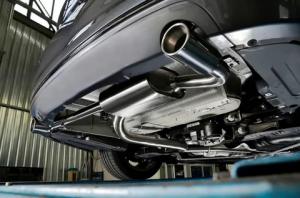Automotive Exhaust Systems Market: Projected Growth from USD 126.8 Billion in 2025 to USD 229.3 Billion by 2035
The automotive exhaust systems market is set to grow significantly, driven by emission regulations, rising vehicle production & demand for aftermarket upgrades.
Additionally, the surge in vehicle production in both developed and developing markets is fueling demand for automotive exhaust systems. Rising disposable income, increased urbanization, and greater access to financing options are contributing to the growing demand for passenger and commercial vehicles globally. Furthermore, there is a sustained demand for aftermarket upgrades and replacements, as vehicle owners seek to enhance vehicle performance, durability, and compliance with emission standards. This presents significant opportunities for manufacturers of exhaust systems, both in original equipment and aftermarket segments.
Get Ahead with Our Report: Request Your Sample Now!
https://www.futuremarketinsights.com/reports/sample/rep-gb-706
Key Takeaways for the Automotive Exhaust Systems Market
• Market Growth: The automotive exhaust systems market is projected to grow from USD 126,816.6 million in 2025 to USD 229,260.9 million by 2035, with a CAGR of 6.1%.
• Emission Regulations: Increasingly stringent global emissions regulations are driving the demand for advanced exhaust technologies.
• Vehicle Production and Demand: Rising vehicle production in emerging and developed markets is boosting the demand for automotive exhaust systems.
• Aftermarket Demand: There is sustained demand for aftermarket upgrades and replacements, contributing to market expansion.
Emerging Trends in the Global Automotive Exhaust Systems Market
Several key trends are influencing the automotive exhaust systems market. A primary trend is the shift toward the development of lightweight and compact exhaust systems. Manufacturers are focusing on reducing the overall weight of exhaust components to improve fuel efficiency and reduce carbon emissions. This is particularly important in the context of electric vehicles (EVs), where energy efficiency is a top priority, and even traditional internal combustion engine (ICE) vehicles are being designed with more eco-friendly features.
Another important trend is the increasing adoption of electric and hybrid vehicles (EVs and HEVs), which are designed with unique exhaust systems to meet lower emissions standards. While EVs do not have traditional exhaust systems, there is a growing focus on developing hybrid powertrains that require specialized exhaust systems to reduce emissions when operating on gasoline engines. This has resulted in the integration of advanced technologies such as active exhaust systems, which can adapt to different driving conditions to optimize performance and minimize emissions.
Furthermore, the ongoing research and development in exhaust gas after-treatment technologies, such as selective catalytic reduction (SCR) and diesel particulate filters (DPF), are improving the overall performance and efficiency of exhaust systems. These systems help reduce harmful emissions, ensuring compliance with global environmental standards and contributing to cleaner air quality.
Significant Developments in the Global Sector: Trends and Opportunities
The automotive exhaust systems market is witnessing significant developments driven by regulatory demands, technological advancements, and consumer preferences. One of the major trends is the increasing implementation of strict emission standards globally. In response, automakers are adopting cutting-edge technologies, such as electric and hybrid vehicle powertrains, to meet increasingly stringent emission norms. In countries like Europe and North America, stricter emissions regulations have compelled automakers to invest in more efficient exhaust systems that minimize environmental impact.
The shift towards electric vehicles and hybrid powertrains presents both challenges and opportunities for the automotive exhaust systems market. While electric vehicles do not require traditional exhaust systems, the growing hybrid vehicle segment presents opportunities for manufacturers to develop advanced exhaust solutions that optimize fuel efficiency and reduce emissions. Companies are also investing in after-treatment technologies to meet stringent emission standards, creating opportunities in the aftermarket and replacement markets.
In addition, there is a noticeable shift toward more sustainable manufacturing practices in the exhaust systems industry. Automakers and exhaust system manufacturers are increasingly adopting environmentally friendly materials and production processes. Recyclable metals and components are gaining popularity, driven by both consumer demand for sustainability and stricter environmental regulations. This trend is contributing to the development of more sustainable exhaust systems that align with the growing eco-consciousness of both manufacturers and consumers.
Recent Developments in the Market
In recent years, there have been numerous advancements in the automotive exhaust systems market. For example, leading manufacturers are investing heavily in research and development to enhance the performance and efficiency of exhaust gas after-treatment systems. Technologies such as selective catalytic reduction (SCR) and lean NOx traps (LNT) are becoming more prevalent in the market as manufacturers strive to meet global emissions standards.
Furthermore, automakers are increasingly focused on improving exhaust system designs to enhance vehicle fuel efficiency. Lightweight materials such as aluminum and titanium are being incorporated into exhaust system components, reducing the overall weight of vehicles and improving fuel economy. Additionally, the advent of active exhaust systems is allowing for more precise control over emissions, further optimizing vehicle performance while adhering to stringent regulatory requirements.
Exhaustive Market Report: A Complete Study
https://www.futuremarketinsights.com/reports/automotive-exhaust-systems-market
Competition Outlook
The automotive exhaust systems market is highly competitive, with key players vying for market share through technological innovation and strategic partnerships. Companies are focusing on improving product performance, expanding their product offerings, and exploring new markets to maintain a competitive edge. The major players are also emphasizing collaborations with automakers to develop customized exhaust solutions for electric and hybrid vehicles, as these segments continue to gain market share.
Key players in the automotive exhaust systems market include:
• Faurecia S.A.
• Bosal Group
• Tenneco Inc.
• Magna International
• Eberspächer Group
• Sejong Industrial Co., Ltd.
• Sango Co., Ltd.
• Benteler International AG
These companies are competing by investing in R&D to develop advanced exhaust systems, forming partnerships with automakers to offer tailored solutions, and expanding their presence in emerging markets to capitalize on growing demand.
Key Segmentation
The automotive exhaust systems market can be segmented based on several factors:
• Type: Exhaust Manifold, Catalytic Converter, Muffler, Diesel Particulate Filter (DPF), Exhaust Gas Recirculation (EGR) Valve
• Vehicle Type: Passenger Vehicle, Commercial Vehicle
• Technology: Traditional Exhaust Systems, Electric Vehicle Exhaust Systems, Hybrid Vehicle Exhaust Systems
• Region: North America, Europe, Asia-Pacific, Latin America, Middle East & Africa
Automotive Chassis System Industry Analysis Reports
Automotive Backing Plate Market Outlook 2025 to 2035
https://www.futuremarketinsights.com/reports/automotive-backing-plate-market
Automotive Intermediate Shaft Market Outlook from 2025 to 2035
https://www.futuremarketinsights.com/reports/automotive-intermediate-shaft-market
Automotive Cast Iron Cylinder Head Market Outlook 2025 to 2035
https://www.futuremarketinsights.com/reports/automotive-cast-iron-cylinder-head-market
Automotive Suspension Control Arms Market Outlook 2025 to 2035
https://www.futuremarketinsights.com/reports/automotive-suspension-control-arms-market
Ankush Nikam
Future Market Insights, Inc.
+ +91 90966 84197
email us here
Visit us on social media:
LinkedIn
Facebook
YouTube
X
Legal Disclaimer:
EIN Presswire provides this news content "as is" without warranty of any kind. We do not accept any responsibility or liability for the accuracy, content, images, videos, licenses, completeness, legality, or reliability of the information contained in this article. If you have any complaints or copyright issues related to this article, kindly contact the author above.
proMX opens four new offices in India
Digital Marketer Nemtcev Shares Insights on Fragrance Preferences in Qatar This May
O.R. TRAX Deployed Across ASCs, Delivering 100% Compliance and Real-Time Notifications
Kalendarium
Więcej ważnych informacji
 Jedynka Newserii
Jedynka Newserii

 Jedynka Newserii
Jedynka Newserii

Infrastruktura

Przed Europą wiele lat zwiększonych wydatków na zbrojenia. To obciąży krajowe budżety
– Bezpieczeństwo militarne trzeba finansować bezpiecznie, uwzględniając bezpieczeństwo finansów publicznych, bezpieczeństwo ekonomiczne – mówi dr Sławomir Dudek, prezes Instytutu Finansów Publicznych. Proponowane przez KE poluzowanie reguły fiskalnej pozwalającej na mocniejsze zadłużanie się rządów to zdaniem ekonomistów krok we właściwym kierunku, ale skuteczny na krótką metę. W dłuższej perspektywie konieczne jest wspólne unijne finansowanie, np. w ramach nowego budżetu UE, i wspólne programy zbrojeniowe, a także szukanie kapitału na rynkach finansowych.
Prawo
Duże projekty fotowoltaiczne w Polsce mocno spowolnione. Największymi problemami nadmierna biurokracja i chaos interpretacyjny

Długotrwałe procedury, nadmierna biurokracja i często niejednoznaczne interpretacje przepisów hamują rozwój fotowoltaiki w Polsce – wynika z raportu Polskiego Stowarzyszenia Fotowoltaiki. Inwestorzy wskazują uzyskanie warunków przyłączenia jako najbardziej problematyczny etap procesu inwestycyjnego. Barierą jest też skala wydanych odmów przyłączenia do sieci, co odstrasza inwestorów. Zmiany są konieczne, zwłaszcza w kontekście dyrektywy RED III, która wskazuje na konieczność przyspieszenia, uproszczenia i ujednolicenia procedur administracyjnych dla inwestycji w OZE.
Konsument
Czterech na 10 Polaków miało do czynienia z deepfake’ami. Cyberprzęstępcy coraz skuteczniej wykorzystują manipulowane treści

Deepfaki, czyli wygenerowane bądź też zmanipulowane przez sztuczną inteligencję zdjęcia, dźwięki lub treści wideo, to jedna z najbardziej kontrowersyjnych technologii naszych czasów. Do jej tworzenia wykorzystywane są zaawansowane algorytmy AI, dlatego użytkownikom coraz trudniej jest odróżnić treści rzeczywiste od fałszywych. Z raportu „Dezinformacja oczami Polaków 2024” wynika, że cztery na 10 badanych osób miało do czynienia z takimi treściami. To o tyle istotne, że deepfaki bywają wykorzystywane do manipulacji, szantażu, niszczenia reputacji, oszustw i wyłudzeń finansowych.
Partner serwisu
Szkolenia

Akademia Newserii
Akademia Newserii to projekt, w ramach którego najlepsi polscy dziennikarze biznesowi, giełdowi oraz lifestylowi, a także szkoleniowcy z wieloletnim doświadczeniem dzielą się swoją wiedzą nt. pracy z mediami.








.gif)



